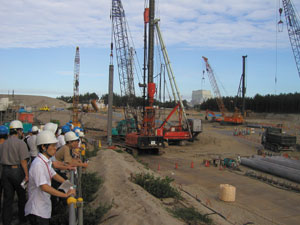Participants at a recent workshop discussed future physics and management issues at the J-PARC facility, which is now under construction in Japan.
Tokai in Japan, which is located on the Pacific coast about 140km northeast of Tokyo and 70 km northeast of the KEK laboratory, is the site of J-PARC, the Japan Proton Accelerator Research Complex. This new facility is based on a 50 GeV proton synchrotron (PS) and, with a beam power of 0.6 MW, will be the most powerful machine at such energies when it starts operation in 2008. Under construction since 2001, J-PARC is being built jointly by two institutes, KEK and the Japan Atomic Energy Research Institute (JAERI). On 2-4 August this year potential users had the opportunity to find out more about the facility when the 3rd International Workshop on Nuclear and Particle Physics at J-PARC (NP04) was held in Tokai.
NP04 followed two similar workshops, in 2001 in Tsukuba and in 2002 in Kyoto, but was special in that it provided the first occasion for future users to discuss a wide range of issues, including the expected performance of the machine and the arrangement of beam lines. They could also voice their wishes and concerns about the type of organization that will govern relationships between them and the J-PARC management. In addition, the workshop provided a wide tour d’horizon of the future physics programmes.

The workshop was divided roughly into four wide domains: strangeness nuclear physics, nuclear hadron physics, kaon rare decays and muon rare decays. When there was overlap between these topics some of the parallel sessions were given in joint sessions covering two or three topics. These physics programmes represent the backbone of research in nuclear and particle physics at the new facility, and most are a continuation of the physics for which KEK has earned its high reputation. The presentations did not include other important programmes for the future facility, in particular neutrino oscillations, which were covered in a separate workshop at KEK on 24-26 August, and a wide range of more application-oriented studies involving neutrons, muon spin rotation and transmutation of nuclear waste.
The first day consisted of plenary sessions devoted to overviews of the accelerator, projected beam lines and physics topics. These were followed by parallel sessions on the mornings of the second and third days. On the afternoon of the second day a visit to the J-PARC construction site gave the participants, most of whom will be future users, the opportunity to view the tremendous progress made by the construction team.
The afternoon of the third and final day was devoted to a discussion of institutional matters. Shoji Nagamiya, director of the J-PARC project, presented the overall framework, and relations with users were discussed by Tadafumi Kishimoto from Osaka University. Kishimoto is a member of a new body called the J-PARC Users Consultative Committee, which is made up of representatives of the different fields, including three representatives from industry and non-voting members of the J-PARC management.

Jen-Chieh Peng from Illinois explained the role of the Nuclear and Particle Physics Facility Committee (NPFC). This is in effect a pre-programme advisory committee, whose duty has been until now to review the 30 letters of intent involving more than 480 authors – including around 60% from foreign institutions – and to advise J-PARC management about machine and beam-line issues based on this review. One of the special tasks of the NPFC was to review the neutrino proposal – whose temporary name is T2K, for Tokai-to-Kamioka, in analogy with the now famous K2K (KEK-to-Kamioka) experiment – which aims to shoot a high-energy neutrino beam towards the SuperKamiokande detector located 295 km away near the coast of the Sea of Japan. Following this review, and the high grade given by the NPFC to the proposal, this project has been funded as an additional facility by the Japanese government.

The NPFC was also charged with classifying the letters of intent into three categories: Day 1 experiments, Phase I experiments and Phase II (and beyond) experiments. Day 1 experiments were selected for their outstanding interest coupled with the fact that they can be realized at the start of J-PARC, within the timeline and budget available for the experimental facilities. Two projects were selected that make partial use of equipment already used at KEK for strangeness nuclear physics.
Phase I experiments are those of great scientific interest that can be done with J-PARC Phase I – PS energy of 30GeV, maximum beam power of 0.45MW for the slow-extracted beam in the hall of initial size – but which require beam lines and/or detectors that are not yet available or financed. Phase II experiments will require not only an extended hall and upgraded beam lines but also the final performance of J-PARC when the injection energy will be pushed to 400MeV, instead of 180MeV in Phase I, and the PS will reach its ultimate energy of 50GeV. Many letters of intent proposed far-reaching additions to the initial facility, including muons (as in the PRISM project) and high-intensity neutrino beams and antiprotons.
The final session was a lively discussion between users and J-PARC management about the roles in the new organization of KEK and JAERI – who finance about 43 and 57% of the new facility, respectively – and about their relationship with the J-PARC Centre, the future body for J-PARC management. An important issue being through which channel future experimental equipment will be funded.
In conclusion, all the participants seemed enthusiastic about the organization and the high level and number of exchanges during this historic workshop. The three days were densely packed, with not much time for tourist distractions, the exception being the beautiful banquet, a much-appreciated Japanese tradition. Another workshop will be organized in 2005 or 2006 as J-PARC comes closer to final completion, and all physicists interested in the new facility will be encouraged to attend.







